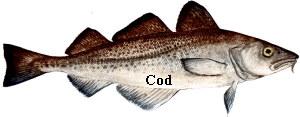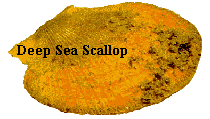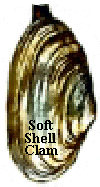GMWSRS


|
Gaskin
Museum of Marine Life - Bay of Fundy/Grand Manan Island
FRESHWATER
FISH: Arthur
MacKay collected specimens of freshwater fishes during field work from
1962-1964. He summarizes his work in "The
Freshwater Fishes of Grand Manan Island. Bay of Fundy, New Brunswick,
Canada." American eel, brook trout, sticklebacks
and mummichog are euryhaline (can survive wide ranges of salt levels) and
no doubt reached Grand Manan via the ocean. Smallmouth bass and brown
trout were introduced. Eastern banded killifish and northern lake
chub are freshwater only. It is not known if they were introduced
as feed for bass or are native. A summary of his findings include:
|
Freshwater
Fish
|
Introduced/Native |
Status
and Distribution
|
|
Brown
Trout (Salmo trutta
L.)
|
Introduced
|
6
fish introduced in Long Pond; status unknown
|
|
Brook
Trout (Salvelinus fontinalis (Mitchill))
|
Native
and Introduced
|
all
drainage systems
|
|
American
Eel (Anguilla rostrata (LeSueur))
|
Native
|
believed
in all drainage systems with connection to ocean
|
|
Eastern
Banded Killifish (Fundulus diaphanus (LeSueur))
|
Native
or Introduced?
|
Millers
Pond, possibly other ponds and streams
|
|
Mummichog
(Fundulus
heteroclitus
(Linnaeus))
|
Native
|
Big,
Long, & Whale Cove Ponds, probably Castalia Marsh and lower reaches
of some streams
|
|
Northern
Lake Chub (Coesius plumbeus (Linnaeus))
|
Native
or Introduced?
|
Millers
Pond
|
|
Smallmouth
Bass
(Micropterus dolomieui Lacepede)
|
Introduced
|
introduced
in Millers Pond and Eel Lake
|
|
Ninespine
Stickleback
(Pungitius pungitius (Linnaeus))
|
Native
|
Long
& Big Ponds, Eel Lake, probably other lakes and streams
|
|
Three-spined
Stickleback
(Gasterosteus aculeatus Linnaeus)
|
Native
|
Salt
water ponds
|
MARINE
FISH: There are over 500 species of fish
found in Atlantic Canada not including 37 species of cartilaginous fish
(sharks, skates, rays & chimaeras); most are recorded from the Bay
of Fundy. However, the number of commercially harvested fish is much less.
These fish can be roughly grouped into groundfish (cod, haddock, pollock,
etc.) those occurring on or close to the bottom, and pelagic - those occurring
in the water column usually away from the bottom (tuna, herring, mackerel,
etc.).
PELAGIC
FISH
 Atlantic
salmon (Salmo salar) is an anadromous fish species, migrating
to the oceans as smolts and returning as adults to spawn in fresh water
streams. A prized sport fish salmon in fresh water are caught in gill nets
or fly fishing, however, the rivers in the Bay of Fundy are closed because
of low returns of spawning salmon. Since the late 1970's, Atlantic salmon
smolts, purchased from fresh water hatcheries, have been kept in sea cages
in the Bay of Fundy and grown to a marketable size (3.6 to 5.5kg or 8 to
12lb). Atlantic
salmon (Salmo salar) is an anadromous fish species, migrating
to the oceans as smolts and returning as adults to spawn in fresh water
streams. A prized sport fish salmon in fresh water are caught in gill nets
or fly fishing, however, the rivers in the Bay of Fundy are closed because
of low returns of spawning salmon. Since the late 1970's, Atlantic salmon
smolts, purchased from fresh water hatcheries, have been kept in sea cages
in the Bay of Fundy and grown to a marketable size (3.6 to 5.5kg or 8 to
12lb). |
GROUNDFISH:
Cod
(Gadus
morhua)
Haddock
(Melanogrammus
aeglefinus)

Pollock
(Pollachius
virens)
Flounders
|
 Bluefin
tuna (Thunnus thynnus) is the largest and fastest of the tuna
reaching lengths of over 270cm (or 9') and a maximum weight of 680kg (or
1500lb). Spawning in warm waters, the adult tuna migrate north to feed
on schooling fish such as herring. Bluefins maintain a constant warm body
by continuously swimming. Bluefin
tuna (Thunnus thynnus) is the largest and fastest of the tuna
reaching lengths of over 270cm (or 9') and a maximum weight of 680kg (or
1500lb). Spawning in warm waters, the adult tuna migrate north to feed
on schooling fish such as herring. Bluefins maintain a constant warm body
by continuously swimming. |

Halibut
(Hippoglossus
hippoglossus)
Hakes
Cusk
(Brosme
brosme)
|
Mackerel
(Scomber
scombrus) |
Redfish
(Sebastes sp.)
Monkfish
(Lophius
americanus)
Hagfish
(Myxine
glutinosa)
|
Herring
(Harengus harengus) a key species in the Bay of Fundy |
|
SHARKS,
SKATES, RAYS & CHIMAERAS
The
Bay of Fundy waters contain many species of sharks, skates and rays despite
the misconception that the waters are too cold for these cartilaginous
fish. Many are only spring to fall visitors but some live year-round. Chimaeras,
another cartilaginous fish, are rarely reported.
Common
Sharks:
Spiny
Dogfish (Squalus acanthias) - The most common shark in the Bay
of Fundy, this small schooling shark  (70-100cm)
is frequently caught during the summer but unfortunately are not usually
sold. A processing plant for dogfish was operated at Ingalls Head on Grand
Manan for a few years until it caught fire from a lightening strike. The
plant was not rebuilt. Spiny dogfish is marketed as "rock shark", "rock
cod" or "rock salmon" and is often eaten in Europe and used for English
fish and chips. Dogfish are also dissected in science classes and a market
for biological supplies exists. It is probably the most written about shark
in the world because of the latter, its abundance and the negative effect
on commercial fisheries. (70-100cm)
is frequently caught during the summer but unfortunately are not usually
sold. A processing plant for dogfish was operated at Ingalls Head on Grand
Manan for a few years until it caught fire from a lightening strike. The
plant was not rebuilt. Spiny dogfish is marketed as "rock shark", "rock
cod" or "rock salmon" and is often eaten in Europe and used for English
fish and chips. Dogfish are also dissected in science classes and a market
for biological supplies exists. It is probably the most written about shark
in the world because of the latter, its abundance and the negative effect
on commercial fisheries.
Photo
modified from Sharks. L Campagno, C Simpfendorfer, JE McCosker,
K Holland, C Lowe, B Wetherbee, A Bush, and C Meyer. Readers Digest Series.
1998. Weldon Owen Pty Ltd., Pleasantville, NY. |
Basking
Shark(Cetorhinus maximus) - The second largest shark (over 10m
or 33'), these slow moving sharks filter feeding on zooplankton by skimming
the small organisms from the water with modified gill structures. Their  gill
slits almost encircled their head and they can be seen swimming just beneath
the surface with their mouths agape, filter feeding. These sharks are locally
called "mud sharks". Basking sharks come to the surface on calm days, and
swim slowly with the top of their dorsal fin exposed, hence the name "basking".
They are proficient at breaching - leaping clear of the water as whales
do, although an explanation for this behaviour in basking sharks is not
readily known. gill
slits almost encircled their head and they can be seen swimming just beneath
the surface with their mouths agape, filter feeding. These sharks are locally
called "mud sharks". Basking sharks come to the surface on calm days, and
swim slowly with the top of their dorsal fin exposed, hence the name "basking".
They are proficient at breaching - leaping clear of the water as whales
do, although an explanation for this behaviour in basking sharks is not
readily known.
Photo
modified from Sharks, History and Biology of the Lords of the Sea.
A. Mojetta. 1997. Swan Hill Press. |
Great
White Shark(Carcharodon carcharias) - These large "man-eaters"
are usually found in the Bay of Fundy between April and November, their
presence noted when caught in fishing gear. The most notable of these occurred
in mid-June,1930, in a herring weir off White Head Island. If authenticated,
it would be the largest great white ever reported (11.28m or 37'), however,
no photographs or verification of the length exists, although a tooth was
donated to the Royal Ontario Museum. The oil from the liver amounted to
955 litres (210 gal) and the stomach contained two and one-half seals. The diet of great
whites is varied, ranging from mackerel, hake, salmon and tuna to other
sharks, seabirds, marine mammals and sea turtles. All great whites examined
from the Bay have had harbour porpoises or harbour seals in their stomachs.
Numbers of sharks is always difficult to determine and may vary greatly
from year to year. There are no recorded "shark attacks" on swimmers in
the Bay.
gal) and the stomach contained two and one-half seals. The diet of great
whites is varied, ranging from mackerel, hake, salmon and tuna to other
sharks, seabirds, marine mammals and sea turtles. All great whites examined
from the Bay have had harbour porpoises or harbour seals in their stomachs.
Numbers of sharks is always difficult to determine and may vary greatly
from year to year. There are no recorded "shark attacks" on swimmers in
the Bay.
Photo
modified from Sharks. L Campagno, C Simpfendorfer, JE McCosker,
K Holland, C Lowe, B Wetherbee, A Bush, and C Meyer. 1998 Readers Digest
Series. Weldon Owen Pty Ltd., Pleasantville, NY |
Thresher
Shark(Alopias vulpinus) - Summer visitors, these medium sized
sharks (3.3 to 5.5 m or 10 to 18')  are
easily recognized because of their long tail, often the same length as
the body. Usually eating schooling fish such as herring and mackerel, or
squid and crustaceans, they use their long tail to circle the fish into
a tight ball. There are stories of threshers attacking whales but these
reports are difficult to verify. are
easily recognized because of their long tail, often the same length as
the body. Usually eating schooling fish such as herring and mackerel, or
squid and crustaceans, they use their long tail to circle the fish into
a tight ball. There are stories of threshers attacking whales but these
reports are difficult to verify.
Photo
modified from Sharks and Rays. TC Tricas, K Deacon, P Last, JE McCosker,
TI Walker, L Taylor. 1997. Nature Company Guides, Time Life Book Series.
Weldon Owen Pty Ltd., San Francisco.
Porbeagle(Lamna
nasus) - Caught in fishing gear incidentally, this medium sized shark
(max. length 3m or 10') is usually marketed as "Mako". Porbeagles eat mostly
herring, mackerel and squid, small cod, hake and cusk. They may occur year
round but are most common from spring to fall. |
Occasional
or Rarely Occurring Sharks:
Shortfin
Mako (Isurus oxyrinchus)
Sand
Tiger Shark (Odontaspis taurus)
Deepsea
Cat Shark (Apristurus profundorum)
Oceanic
Whitetip Shark (Carcharhinus
longimanus)
Dusky
Shark (Carcharhinus obscurus)
Smooth
Dogfish (Mustelus canis)
Blue
Shark (Prionace glauca) |
Atlantic
Sharpnose Shark (Rhizoprionodon terraenovae
Smooth
Hammerhead (Sphyrna
zygaena)
Black
Dogfish (Centroscyllium fabricii)
Portuguese
Shark (Centroscymnus coeloepis)
Rough
Sagre (Etmopterus princeps)
Greenland
Shark (Somniosus microcephalus) |
For
more great info on shark biology, anatomy and research check out the Canadian
Shark Research Laboratory.
| Common
Skates & Rays: |
|
| Little
Skate (Raja
erinacea) - Bottom living, winter residents, they reach a max. length
of 53 cm (or 21"). They eat bottom living invertebrates such as crustaceans.
Of little value to the fishing industry, they are used for fish meal. They
are also used as laboratory animals. |
Barndoor
Skate (Raja laevis) - Bottom living, probably year-round, they
reach a length of 127-142cm (or 50-56"). They eat bivalves, squid, rock
crabs, lobsters, shrimp, marine worms, and a variety of fish. Of little
value to the fishing industry, they are sometimes ground into fish meal. |
| Winter
Skate (Raja ocellata) - Bottom living, winter residents, they
reach a length of 80cm (or 31"). They eat crustaceans, small fish, and
bivalves. Of little value to the fishing industry, they are sometimes ground
into fish meal. They are also used occasionally as laboratory animals. |
Thorny
Skate(Raja radiata) - Bottom living, found year round, they
reach max. lengths of 100 cm (or 39") although size varies with location.
They eat polychaetes, crustaceans and fish. Of little value to the fishing
industry, they are sometimes ground into fish meal. In Europe these skates
are marketed for human consumption. |
| Smooth
Skate (Raja senta) - Bottom living, year round residents, they
reach max. lengths of 60 cm (24"). They feed on crustaceans. Of little
value to the fishing industry, they are sometimes ground into fish meal. |
|
|
|
| Rarely
Occurring or Occasional Skates & Rays: |
|
Atlantic
Torpedo (Torpedo nobiliana) - Although not common it is worth
noting that this ray can truly be called "electric". Electric shocks are
emitted when the ray is touched in the head region. It ranges from 1.5-1.8m
(5-6') in length and is usually found in warmer waters but specimens have
been collected from Grand Manan waters.
Deepwater
Skate (Bathyraja richardsoni)
Spinytail
Skate (Raja spinicauda)
Roughtail
Stingray (Dasyatis centroura) |
Chocolate
Skate (Raja
bathyphila)
Round
Skate (Raja fyllae)
Shorttail
Skate (Raja jenseni)
White
Skate (Raja lintea)
Soft
Skate (Raja mollis)
Pelagic
Stingray (Dasyatis violacea)
Atlantic
Manta (Manta birostris) |
|
|
| Rarely
Occurring or Occasional Chimeras: |
|
| Longnose
Chimaera (Harriotta raleighana) |
Knifenose
Chimaera (Rhinochimaera atlantica) |
| Deepwater
Chimaera (Hydrolagus affinis) |
|
References:
Scott,
W.B. and M.G. Scott. 1988. Atlantic Fishes of Canada. Can.Bull.Fish.Aquat.Sci.
219:731pp.
Canadian
Shark Research Laboratory
COMMERCIAL
INVERTEBRATE SPECIES

|
Lobsters
(Homarus americanus) are a predatory clawed crustacean which can
attain large sizes (64cm or 25" and over 13.5kg or 30lb). Lobsters are
also scavengers. They have both a "pincer" and a "crusher" claw.
Lobsters are caught in traps and cooked in the shell either boiled or steamed. |
Scallops
(Placopecten magellanicus) are a filter feeding, bivalve mollusks
that can reach 20cm (8"). The "meat" is actually two muscles used to regulate
opening and closing of the shells. Scallops are a prized seafood dragged
from the bottom. Artificial scallops are often available at a lower
price in fish markets but are usually made from skate wings. |

|

|
Sea
urchins (Strongylocentrotus droebachiensis) are a spiny invertebrate
with five-sided symmetry related to sea stars. Urchins attained a size
of 75mm or 3" and are usually green with a purplish hue. The spines are
relatively short. Urchins graze algae and other material from rocks with
a specialized mouth part, called an "Aristotle's lantern". They also scavenge
and are attracted to baited lobster traps. When found in tide pools, gulls
readily consume urchins by breaking them open. Urchins sometimes camouflage
themselves with bits of seaweed, shells and small pebbles. Urchins are
harvested primarily for the roe or eggs which are used in sushi. |
| Common
periwinkles (Littorina littorea) were brought to Nova Scotia
from Europe in the 1800's and have colonized the Maritimes. This marine
snail up to 31mm (or 1 1/4") is brownish with stripes around the shell.
Periwinkles are grazers of seaweeds. By late summer many seaweeds show
the effect of grazing - small holes through the fronds or ragged edges,
but not all holes in seaweeds are caused by periwinkle; some algae like
the colander kelp (Agarum cibrosum), are naturally "holey". Periwinkles
are usually steamed and then picked out of the shell. |

|

|
A
bivalve mollusk, soft-shelled clams (Mya arenaria) are filter
feeders reaching up to 150mm or 6". The clams remain buried in mud or gravel/mud
mixture throughout the tide cycle and have a retractable siphon or neck
which can be extended to the surface when the tide is in or retracted when
the tide is out. This is the clam which squirts water upwards when you
walk over tideflats. These clams are usually steamed which gives them their
other name - steamer clams. |
| Jonah
Crab (Cancer borealis) A crab similar to the rock crab but slightly
larger (to 156 mm or 6.25"). Jonah crabs are caught in traps and used mostly
for the claws. |
Pink
(Red) Shrimp (Pandalus borealis) reaches lengths of 120 mm or
5". This shrimp is usually in deep water. It is the only shrimp
harvested in the Bay of Fundy. |
| Squid
(Short-finned: Illex illecebrosus, Long-finned: Loligo
pealei) Abundant shallow-water squid species preyed upon by various
species of fish, sharks and marine mammals. Squid often eat small herring,
mackerel and krill. Long-finned quid are typically much larger than short-finned
squid, with mantle lengths of 425 mm (17") compared to 225 mm (9") respectively.
Used as bait frequently but also eaten. |
Quahogs
(Mercenaria mercenaria) are filter feeders with shells 100-150 mm
(4-6"), thick, oval-shaped and strong. These clams are dredged from
the bottom. Littlenecks, Cherrystone and Chowder are names given
to various sizes of quahogs. The scientific name Mercenaria
is derived from the native use of the shell as wampum or currency. |
|

![]()

![]()

